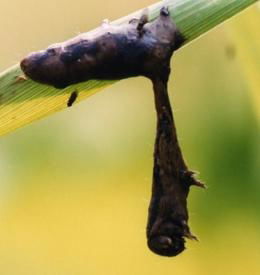News to Note, December 31, 2011: Year in Review
A weekly feature examining news from the biblical viewpoint
Forensic fantasy in London, Foghorn Leghorn with teeth, zombie’s curse, ancient antibiotic resistance, circular clock
Here at the end of 2011, we review highlights from the News to Note year. We have marveled at the wonders of God’s Creation and shaken our heads when God’s wondrous works have been attributed to time and chance and death—the agents of evolution. We hope you enjoy this special illustrated perspective on the news.
- Forensic fantasy in London
- Foghorn Leghorn with teeth
- Zombie’s curse
- Ancient antibiotic resistance
- Circular clock
- And Don’t Miss . . . this deadline!
1. dailymail.co.uk: “Smile from 2m years ago: Revealed, the face of the ‘missing link’ between ape and man”
Karabo—“the answer”
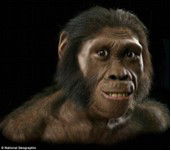
The latest candidate for oldest human ancestor grabbed a whole issue of Science and later returned with a new name and a forensic makeover as Karabo—“The Answer”—described here in a reprint from November 26.
Australopithecus sediba got a makeover to celebrate the display of his mortal remains in London’s Natural History Museum. The “boy,” who along with his “mother” was presented to the scientific public in the September 9 issue of Science, underwent “forensic reconstruction” to produce a portrait perfect for his role as oldest ape-boy. Along with the picture comes his new name, Karabo, meaning “the answer,” as he is supposedly the answer to the evolutionary quest for the missing link.
Lee Berger—Karabo’s discoverer, publicist, and greatest fan—says the intact skull made this realistic portrait (left) possible. “That is probably him. Normally with early human fossils, they are in such lousy condition, but here the anatomy is pretty much fixed. I think it’s the most accurate that’s ever been done. It’s a more human-like nose than we have seen before, he’s just wrinkling it because he’s smiling, chimps can’t smile.” Thus, since chimps can’t smile, and Karabo can, Berger is telling us Karabo really is the missing link between apelike ancestors and humans.
Berger asserts his South African fossil is the oldest known direct ancestor of Homo erectus. He points out the long thumb on the “human-like” hand, saying, “We’ve never seen that before. It really is undeniable when you lay it in your hand that it’s not a chimp. It looks like a hand capable of making tools. He shares more with humans than anything else ever discovered but is still so primitive and that’s exciting.”
Not all experts agree with Berger’s assessment that Au. sediba’s hand anatomy suggests Karabo used tools. The long “human-like” thumb is actually much longer than a human thumb, and the fingers are all proportionately shorter than those of humans. Paleoanthropologist William Jungers of Stony Brook “has seen the original fossils. He thinks [the hand is] ‘an australopithecine hand in essentially all relevant respects’ and didn’t manipulate objects in an advanced humanlike way.”
The portrait retains the flat forehead, prominent brow, and jutting jaw of the ape that Karabo was. His face has lost some of the ape-slope seen on the real skull. Karabo has also acquired extra cranial capacity since we saw him in September!1
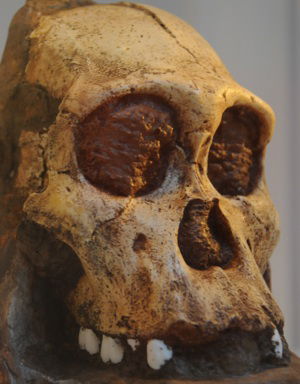
Photo by Dr. Elizabeth Mitchell at Natural History Museum, London
Actual human skull, for comparison (below). (photo from “Did Humans Really Evolve from Apelike Creatures?”)

Paleo-artist John Gurche gave Karabo a fetching thin-lipped smile to go with his wrinkled nose, furrowed brow, hip haircut with neatly trimmed facial hair, and expressive eyes in which white sclera shine forth his humanity. And while Berger claims the only guesswork on the artist’s rendition is the hair pattern and skin tone, fossilized skulls do not preserve a nose (wrinkled or otherwise), lips, or expressive eyes. The original fossil did not have even an elevated nasal bone. The fossil record of scleral color is, to say the least, nonexistent. And there is no such thing as a fossilized smile. Karabo’s portrait drips with far more humanity than typical forensic reconstructions publicized by law enforcement. In short, Karabo seems the consummate ape-boy, blending skeletal features of ape and human with fleshed out human features and the emotionally charged eyes of a bright, happy young man.
What better way for Berger bring his case before the public? Seeing is believing. But painting happy eyes and a smile on an artistically enhanced skull does not make Karabo “the answer” to the quest for a missing link. Karabo’s skeletal features are typical of apes, not humans. None of its skeletal parameters are transitional forms en route to becoming human but are simply minor variations of features found on apes.
Karabo is probably a variation within the australopithecine kind, but it definitely is not a human ancestor. Genesis tells us that God created humans and land animals on the sixth day, but only humans are made in the image of God. Man is unique physically, mentally, and spiritually. Any similarities shared with apes occur because we share a common Designer, not a common ancestry. “The answer” is in Genesis, not the Natural History Museum. And the only missing links are in the minds of evolutionists like Berger.
Follow up:
I visited London’s Natural History Museum in December. Only the replica of Karabo's skull was on display. As seen in its photograph above, the skull’s projecting lower face and flattened nasal bones are typical of apes, not humans. (See photo of actual human skull, for comparison.)
Further Reading
2. Wired : “How to Hatch a Dinosaur” as reprinted here from October 22, 2011.
“It’s not like a Mr. Potato Head.”

This year has brought Jurassic “[fill in the blank]” full circle by following up Jurassic Park, Jurassic Prank: A Dinosaur Tale, and “Jurassic Spark” with “Scientists Rewind Evolution With Unique Chicken Embryo,” as well as a Chinese “Jurassic mother,” and David Attenborough’s recent “Jurassic lark.” But it’s Jack Horner’s ongoing quest to build a dinosaur that caught our eye with the cover of Wired (left).
Jack Horner’s efforts to make a chickensaurus are in the news again, and the cover of Wired has eye-catching artwork boldly asserting, “Scientists know how to turn a chicken into a dinosaur.” Horner’s pronouncements guided the creators of Jurassic Park as they popularized the notion that dinosaurs evolved into birds. (Be sure to read Horner’s quotation regarding the movie in “Jurassic Spark?” Ironically, scientists with doctoral degrees and a biblical worldview are ridiculed while Horner, lacking a college degree, is hailed as an expert.) Horner claims dinosaur genes are in the chicken genome and just need to be switched on. Not all evolutionists believe “reverse evolution” is possible. Harvard’s Matthew Harris points out, “You can’t even find a gene for enamel in the chicken genome.” Others, like biologist Sean Carroll, explain there is more to reverse evolution than flipping switches. He says:
It’s not like a Mr. Potato Head, where you just give it a tail and new hands and voilà: dinosaur. That tail has got to work with the rest of the body. There’s likely going to be some wiring problems, some coordination problems. Maybe some other body parts won’t develop normally. . . . Even if you raised an adult chicken with teeth, you’d really end up with nothing more than Foghorn Leghorn with teeth.
The Bible asserts that God created all creatures to reproduce after their kinds. This biblical truth is confirmed in science: each organism has genetic information to vary within its kind but is unable to acquire information to evolve into a new kind of organism. There are genetic similarities among different kinds because our common Designer—God—utilized similar designs to meet various biological needs.
3. Smithsonian: “The Scariest Zombies in Nature”
Genesis of the zombie’s curse.
Zombies aren’t just for science fiction. Parasites able to turn their victims into zombies are unsettling. But natural selection’s secret recipes for zombies are coming to light.
“Zombies have a long natural history, stretching back tens of millions of years, and nature is filled with creeping, oozing, blood sucking and otherwise ghastly creatures just as terrifying as anything Hollywood could concoct.” So writes Brian Switek, author of Written in Stone: Evolution, the Fossil Record, and Our Place in Nature. Switek’s pre-Halloween article for Smithsonian Magazine catalogues a number of these ghoulish parasites. He quotes ecologist David Hughes, who has worked with zombie ants: “Now that we know the behavior like this can fossilize, I would not be surprised if we find more. I believe samples tens of millions of years older are likely.”
The “fossilized behavior” Hughes speaks of refers to fossil evidence that fungal infestation of insects produced the same alterations in behavior long ago as those we see today. For instance, today we know the fungus Ophiocordyceps unilaterius parasitizes ants, prompting them to climb to a certain level in the jungle canopy, bite down on the shady underside of leaves where the temperature and humidity are optimal for fungal growth, and remain there until death. Fossilized leaves from Eocene rock (48 million years ago by evolutionary dating) in Germany preserve markings like those left by the ants on modern leaves.
Of course, the claim that these parasites and their zombie-creating effects are millions of years old comes from the radiometric dating of the rock layers in which such fossils are found. Radiometric dating methods are all based on a number of unverifiable assumptions. (See “Radiometric Dating: Back to Basics,” “Radiometric Dating: Problems with the Assumptions,” and “Radiometric Dating: Making Sense of the Patterns.”)
Switek’s article reviews the “evolutionary success” of a number of parasites infecting ants and snails. He concludes, “It’s not yet clear what chemicals signals alter the behavior and appearance of parasitized ants and other victims,” but “Parasites have evolved to be masters of manipulation.”
All of the zombie-makers in Switek’s hall of creepy fame share a key feature: they affect their hosts so as to enhance their own growth and dispersion. For instance, the snail parasite he describes is a flatworm that infects snail eye stalks. The infected eye stalks are brightly colored and readily attract the attention of hungry birds. The parasites are of course eaten along with the unfortunate snails. The flatworms complete their life cycle inside bird digestive systems, leaving eggs to be deposited in bird droppings where they will be consumed by more snails.
Some scientists and fiction writers tend to personify evolution’s ability to manipulate the behavior of parasite victims. Evolutionist Richard Dawkins coined the term extended phenotype to refer to the fact that, while a gene can only encode for the production of a particular protein, a gene’s “extended phenotype” includes all the effects that gene has on all the organisms it affects.
In trying to discover a mechanism by which a gene can extend its phenotype, researchers working with another zombie-like insect (see “Parasites Affect Behavior of Moths”) discovered, in the words of David Hughes, “the first empirical evidence that a gene in the body of one organism can have a direct effect on another organism.” (see www.nature.com/news/2011/110908/full/news.2011.526.html ) A virus affecting gypsy moth caterpillars indirectly prompts the insects to die in treetops by coding for an enzyme that deactivates the hormone that triggers molting. Caterpillar molting behavior is linked to lingering at lower altitudes, so, with no hormonal prompting to molt, the hapless hosts blissfully ascend to die at a location optimal for viral dispersion (see disturbing photo below). This chain of causation illustrates the complexities of natural selection at work in the 6,000 years since the Fall of man and the resultant Curse on creation.
As with the gypsy moth, so with these ant parasites and snail parasites, no new kinds of organisms are evolving. Natural selection is “rewarding” the most effective dispersal strategies. Those parasites that happen to infect their unfortunate hosts in ways that impair neural or hormonal control of behavior or make the hosts particularly vulnerable to predators are naturally selected through successful dispersal.
Genesis says that God called His Creation “very good,” so we are confident that fungi, viruses, bacteria, and even flatworms fulfilled helpful, not harmful, roles in that original world. Since the Fall, a combination of mutations, horizontally transferred genes, environmental changes, and host changes have left us with a number of harmful microorganisms in addition to those that still fulfill vital ecological roles. The zombie-making parasites Switek describes, despite the title of his book, are just reminders of the way natural selection has functioned in this fallen world, not personifications of evolution explaining fossilized behavior. No doubt additional research will elucidate more complicated mechanisms by which natural selection—not evolution—produced extended phenotypes.
Further Reading
- Get Answers: Suffering
4. ScienceDaily: “Resistance to Antibiotics Is Ancient”
Actually, antibiotic resistance is not evolving.
God created microbes for important functions in this world, and despite sin’s curse upon creation most of those functions still work. But when things go wrong, sometimes they go very wrong, as we saw in the European E. coli epidemic. Yet despite the battle cry, “Their weapon is evolution,” those highly virulent E. coli were still E. coli. Microbes are able to horizontally transfer information, and natural selection allows microbes possessing resistance genes to survive and thrive. Such changing virulence and antibiotic resistance prove nothing about evolution of one kind of organism into another but merely illustrate the effect of natural selection on microbial populations.
Bacteria from the permafrost of the Yukon Territory have been revived and coaxed to reveal its secrets. A team from McMaster University has re-discovered the phenomenon of ancient antibiotic resistance and demonstrated it in a new direct way.
Antibiotic resistance has long been a problem, especially in hospital settings where lots of antibiotics are used. Pathogens resistant to antibiotics survive and take over, causing many difficult-to-treat infections. Many claim that antibiotic resistance is the observable proof of evolution. But are bacteria really evolving?
Back in 1988, explorers frozen in 1845 were autopsied at the University of Alberta, and six strains of bacteria isolated from their colons were revived. According to microbiologist Dr. Kinga Kowalewska-Grochowska, “Three of them also happen to be resistant to antibiotics. In this case, the antibiotics clindamycin and cefoxitin, both of which were developed more than a century after the men died, were among those used.”2
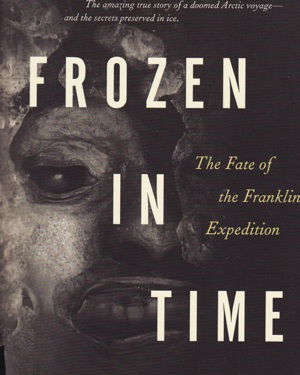
Cover of Frozen in Time by Owen Beattie and John Geigler, which chronicles the fascinating forensic mystery of the Franklin expedition, the explorers whose bodies gave us our first evidence of ancient antibiotic resistance.
Now researchers have gone a step further. They have isolated bacterial DNA from Ice Age permafrost3 and found genes coding for resistance to several classes of antibiotics, including β-lactams, tetracycline, and glycopeptide antibiotics.4
Then, focusing on the genes encoding vancomycin resistance, they recreated those gene products in the lab. The three enzymes thus produced worked together to resist vancomycin in the same way as their modern counterparts.5 They conclude, “Antibiotic resistance is a natural phenomenon that predates the modern selective pressure of clinical antibiotic use.”6
So how did the bacteria already have suitable weapons years before their enemy was invented? Antibiotics and their antidotes are actually natural substances produced by fungi, algae, and bacteria. Dr. Gerry Wright explains, “Antibiotics are part of the natural ecology of the planet so when we think that we have developed some drug that won't be susceptible to resistance or some new thing to use in medicine, we are completely kidding ourselves. . . . Microorganisms have figured out a way of how to get around them well before we even figured out how to use them.” He adds, “Antibiotics are remarkable resources that need to be carefully husbanded.”
Some of this genetic material is in a form that can be transferred to other microorganisms. Microbiologist Dr. Stuart Levy, who has warned of profligate use of antibiotics for 30 years, explains, “What had been missed in the 1960s and 1970s was the ease with which resistance could appear,” he said. “Bacteria share these genes like baseball cards with each other.”7
So is antibiotic resistance the poster-child of evolution? No. There was a time when people thought bacteria evolve resistance because they “need” to. But—as demonstrated in this study and in the 1988 one—the variations and mutations that confer resistance are already in the genomes of some bacteria. The “resistance information” does not necessarily develop in response to the antibiotic threat. Natural selection allows resistant bacteria to survive and reproduce, replenishing the bacterial population. And those surviving bacteria are still bacteria—the same kind of bacteria they were all along.
Antibiotic resistance not only fails to prove the evolution of new kinds of organisms but actually demonstrates our Creator’s wisdom. We believe that God provided many mobile bits of information8 to enable microorganisms to survive and fulfill their complex ecological roles. Changing conditions in the post-Fall world have allowed helpful bacteria to become dangerous (see The Genesis of Pathogenic E. coli). A combination of mutations, horizontally transferred genes, environmental changes, and host changes can transform harmless microorganisms into pathogens. Frankly, from an evolutionary point of view, killing the host is a particularly bad idea! Biblical understanding explains the phenomenon of antibiotic resistance.
Further Reading
5. Physorg: “Research team finds new explanation for Cambrian explosion”
Cambrian secrets of small beginnings
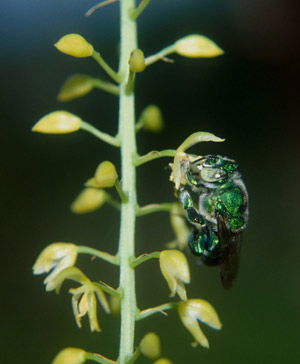
Orchid bee and Notylia orchid, as mentioned in “Bees and Orchids: Which is “Evolving” Faster?.” Photo from newscenter.berkeley.edu/2011/09/22/bees-outpace-orchids-in-evolution
Molecular clock conclusions are a constant feature in scientific reports that create evolutionary phylogenetic trees. Appearing to have mathematical precision, molecular clocks dictate appear authoritative and indisputable. Yet molecular clocks depend upon unverifiable assumptions about the unobservable untestable past. For instance, mutation rates must be constant for the data to have any value at all. Even in the short term, that assumption has already been found invalid for humans. (See “Molecular clock off-line.”) Researchers working with orchid-bee relationships noted, “Molecular clock estimates may suffer from biases due to incomplete lineage sampling, substitution rate heterogeneity, or sparse fossil data.”9
But the root of the problem goes deeper, to the heart of the statistical methods involved, as described in this reprint about the Cambrian explosion.
Darwin was troubled by the sudden appearance of multicellular organisms “in the lowest known fossiliferous rocks”—the Cambrian explosion. He “argued that the incompleteness of the fossil record gives the illusion of an explosive event, but with the eventual discovery of older and better-preserved rocks, the ancestors of these Cambrian taxa would be found.10 Since the fossil record has failed to provide sufficient ancestral forms, the magical world of mathematics has stepped in to fill the gap, giving new significance to Precambrian microfossils.
In Darwin’s view, Precambrian rocks contained no fossils. Evolutionary scientists have not thought that the Precambrian microfossils discovered since Darwin’s day are ancestrally sufficient to explain the diverse multitude of Cambrian creatures. Because evolutionists believe life evolved in a series of small steps over millions of years, the missing ancestors represent a real conundrum.
An international team of researchers has been crunching numbers from both paleontology and molecular genetics to solve this age-old mystery. They say they’ve found the secret of the Cambrian “illusion.”
Using a divide-and-conquer approach, half of these paleo-detectives analyzed the “precise temporal framework”11 of the fossil record while the other half collated data drawn from a “rigorous understanding of the phylogenetic relationships”12 between extant and fossilized organisms and “their dates of origin.”13 When they compared notes, they found “the basic genetic components for the organisms that seemingly sprang into existence during the Cambrian period were in place long before the fossil records show.” They calculated these genes got the jump on the Cambrian fossils by 200 million years.
And where were these genes lurking? In those Precambrian microfossils! “The unavoidable conclusion from the molecular record is that precambrian animals are largely stem lineages leading to extant phyla.”14 This “macroevolutionary lag,”15 they write, lasted until ecological conditions adjusted to the influences these primordial life-forms were having on the earth and also until regulatory genes could evolve. Since similar protein molecules appear in multiple organisms, the researchers believe regulatory genes to individualize protein expression had to evolve just prior to the evolution of diverse multicellular life-forms.
The only way to distinguish “evolutionary origins from geological first appearances . . . is to use a molecular clock,”16 the team writes. While asserting the molecular clock distinguishes between the two halves of “the fossils-and-genes crowd,”17 both groups are really using information built on the same assumptions. The results, therefore, give the illusion of remarkable precision in their correlation of data, but those data consist of numbers all drawn from the same source. What the researchers have built is an elaborate system of statistical circular reasoning.
A 2004 study published in Trends in Genetics details how molecular clocks offer an “illusion of precision . . . achieved mainly through the conversion of statistical estimates (which by definition possess standard errors, ranges, and confidence intervals) into errorless numbers. By employing such techniques successively, the time estimates of even the most ancient divergence events were made to look deceptively precise.”18 The product of such molecular clock calculations has been “an exhaustive evolutionary timeline that is enticing but totally imaginary.”19
Molecular clocks, built on the assumption that mutation rates have remained constant, are correlated with radiometric dating methods. In fact, they actually hinge on “a single calibration point that has been unjustly denuded of error.”20 Such methods do not provide the promised “precise temporal framework.” Instead, they are built on unverifiable uniformitarian assumptions that ignore changes in earth’s history, particularly the catastrophic influence of the global Flood on geology. And even if those dating assumptions were true, “no geological dating is without error.”21 Statistical mismanagement of such dates has built a molecular clock database on shaky sand.
Furthermore, the demand for evolutionary ancestors assumes that one kind of organism can accumulate information through mutations and evolve into another kind of organism. However, mutations involve a loss of information. Indeed, a 2010 study in Trends in Genetics points out that “most studies of recent evolution involve the loss of traits, and we still understand little of the genetic changes needed in the origin of novel traits.”22
Since this secret to the Cambrian mystery is the real illusion, we need to look elsewhere to explain the sudden change between the Precambrian and Cambrian rocks. The answer is in Genesis. God created all kinds of living things during Creation Week and designed each to reproduce after its kind, not to evolve into new kinds. Most creationist geologists believe the Precambrian rock layers were present prior to the global Flood. The upheavals of the Flood then buried countless marine invertebrates as the first impact of God’s catastrophic judgment, trapping them in the sediments now making up the Cambrian layers. The secret of the Cambrian explosion has been available in the Bible all along.
Further Reading
- Get Answers: The Flood
And Don’t Miss . . .
-
The deadline for papers to be submitted for the 2013 International Conference on Creationism is January 31, 2012.
The Seventh International Conference on Creationism (ICC) will meet in Pittsburgh, Pennsylvania, on August 4–7, 2013. The theme will continue to be “Developing and Systematizing the Creation Model of Origins.” Sponsored by the Creation Science Fellowship, Inc., the ICC is a working conference where researchers and creation scientists gather to work out the details of the creation model. The ICC, established in 1986, has become the premier peer-reviewed creation conference. Research from previous conferences has contributed to our understanding of catastrophic plate tectonics, magnetic field reversals, baraminology, paleo-climatology, and evidence indicative of a young-earth. ICC sponsors encourage creation researchers from around the globe to submit ideas for papers and topics. Interested authors should submit a minimum 1000–2000 word summary, categorized according to the ICC’s Area/Sub-Area classification no later than January 31, 2012 (see the ICC site for further instructions on where and how to send the file). Papers dealing with the age of the earth/universe must be from a young-earth perspective. Papers from an old-earth, geocentric, anti-relativity, or anti-quantum mechanics perspectives will not be considered. More details are available through the Official 2013 ICC Web Site at www.creationicc.org. We join the sponsors in encouraging creation scientists to be part of this event. The ICC provides a unique opportunity for scientists who understand the principle that true science will never conflict with our Creator God’s truth as revealed in His Word.
As we enter 2012 we look forward to seeing what scientists will actually discover as well as what some scientists will think they’ve proven. We hope you will continue to study God’s Word, read the news and scientific papers with discernment, and teach your children to do the same. We challenge you to “be ready always to give an answer” (1 Peter 3:15) to everyone that wonders why we trust Jesus Christ the Creator (Colossians 1:16) and “Savior of the world” (John 4:42).
For More Information: Get Answers
Remember, if you see a news story that might merit some attention, let us know about it! (Note: if the story originates from the Associated Press, FOX News, MSNBC, the New York Times, or another major national media outlet, we will most likely have already heard about it.) And thanks to all of our readers who have submitted great news tips to us. If you didn’t catch all the latest News to Know, why not take a look to see what you’ve missed?
(Please note that links will take you directly to the source. Answers in Genesis is not responsible for content on the websites to which we refer. For more information, please see our Privacy Policy.)
Footnotes
- Sediba with a Little Sleight of Hand
- Struzik, Ed. 1990. Ancient bacteria revived. Sunday Herald (Calgary, Alberta, Canada), A1, which was quoted in Alan Gillen’s book Genesis of Germs, p. 19. The findings were also published in McGuire, R. 1988. Eerie: Human Arctic fossils yield resistant bacteria. Medical Tribune, pp. 1, 23.
- Great care was taken to confirm the bacteria were uncontaminated and were truly of Ice Age origin. Other DNA in the sample came from Ice Age flora and fauna and not from modern creatures. Carbon dating produced an age of 30,000 years. Carbon dating fails to account for changes in the earth’s magnetic field and for the removal of much of the earth’s biomass in the Flood. Therefore the dates obtained are longer than they should be (www.nature.com/nature/journal/vaop/ncurrent/full/nature10388.html). For more information about carbon dating, see A Creationist Puzzle, Carbon-14 in Fossils and Diamonds, Carbon-14 Dating, and Doesn’t Carbon-14 Dating Disprove the Bible?.
- www.nature.com/nature/journal/vaop/ncurrent/full/nature10388.html
- www.nature.com/nature/journal/vaop/ncurrent/full/nature10388.html
- www.nature.com/nature/journal/vaop/ncurrent/full/nature10388.html
- www.nytimes.com/2011/09/01/science/01gene.html
- The Role of Genomic Islands, Mutation, and Displacement in the Origin of Bacterial Pathogenicity
- Ramírez et. al. 2011. “Asynchronous Diversification in a Specialized Plant-Pollinator Mutualism,” Science 333:1743. Quoted in Bees and Orchids: Which is “Evolving” Faster?
- Erwin, D. 2011. The Cambrian Conundrum: Early Divergence and Later Ecological Success in the Early History of Animals. Science 334, no. 6059:1091–1097.
- Erwin, D. 2011. The Cambrian Conundrum: Early Divergence and Later Ecological Success in the Early History of Animals. Science 334, no. 6059:1091–1097.
- Erwin, D. 2011. The Cambrian Conundrum: Early Divergence and Later Ecological Success in the Early History of Animals. Science 334, no. 6059:1091–1097.
- Erwin, D. 2011. The Cambrian Conundrum: Early Divergence and Later Ecological Success in the Early History of Animals. Science 334, no. 6059:1091–1097.
- Erwin, D. 2011. The Cambrian Conundrum: Early Divergence and Later Ecological Success in the Early History of Animals. Science 334, no. 6059:1091–1097.
- Erwin, D. 2011. The Cambrian Conundrum: Early Divergence and Later Ecological Success in the Early History of Animals. Science 334, no. 6059:1091–1097.
- Erwin, D. 2011. The Cambrian Conundrum: Early Divergence and Later Ecological Success in the Early History of Animals. Science 334, no. 6059:1091–1097.
- Intertwining Evolution and Linguistics Breeds Controversy
- www.sciencedirect.com/science/article/pii/S0168952503003421
- www.molevol.de/publications/117.pdf
- www.sciencedirect.com/science/article/pii/S0168952503003421
- www.molevol.de/publications/117.pdf
- http://heliconius.zoo.cam.ac.uk/publications/Nadeau_TIG2010.pdf
Recommended Resources

Answers in Genesis is an apologetics ministry, dedicated to helping Christians defend their faith and proclaim the good news of Jesus Christ.
- Customer Service 800.778.3390
- © 2024 Answers in Genesis

